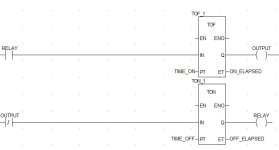Dear all,
First of all thanks for letting me join this forum.
I just need some help in one of my programming exercises. Being a beginner, I'm still having a hard time figuring out how to properly plan the logic (for example, how to determine which input/output do I need to use to reset a timer). Hope you can share your strategy on how I can effectively plan before staring the ladder programming.
By the way, this is the scenario that I am currently working on. Hope you can share your thoughts on how I can figure this out. I don't necessary need you to provide me the ladder logic for this. Just give me some guidance.
1. When button A is pressed, green light will turn on.
2. When button B is pressed, red light will t urn on.
3. When both buttons are pressed, green and red light will alternately turn on every 1 second.
4. When both buttons are released, both lights will be off.
Thanks in advance. Cheers!
First of all thanks for letting me join this forum.
I just need some help in one of my programming exercises. Being a beginner, I'm still having a hard time figuring out how to properly plan the logic (for example, how to determine which input/output do I need to use to reset a timer). Hope you can share your strategy on how I can effectively plan before staring the ladder programming.
By the way, this is the scenario that I am currently working on. Hope you can share your thoughts on how I can figure this out. I don't necessary need you to provide me the ladder logic for this. Just give me some guidance.
1. When button A is pressed, green light will turn on.
2. When button B is pressed, red light will t urn on.
3. When both buttons are pressed, green and red light will alternately turn on every 1 second.
4. When both buttons are released, both lights will be off.
Thanks in advance. Cheers!




